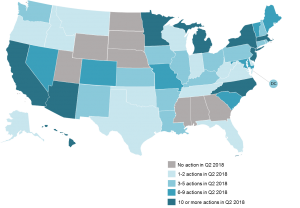The 50 States of Grid Modernization: Over 300 Grid Modernization Actions Taken in Q2 2018
Raleigh, NC – (August 1, 2018) The N.C. Clean Energy Technology Center (NCCETC) released its Q2 2018 edition of the 50 States of Grid Modernization. The quarterly series provides insights on state regulatory and legislative discussions and actions on grid modernization, utility business model and rate reforms, energy storage, microgrids and demand response.
The report finds that 42 states and the District of Columbia took actions related to grid modernization during Q2 2018 (see figure below), with the greatest number of actions relating to advanced metering infrastructure rules, energy storage deployment, utility business model reforms, data access and grid modernization investigations.
A total of 302 grid modernization actions were taken during Q2 2018, representing an explosive increase in state activity in the first half of 2018. New York, California and Massachusetts took the greatest number of actions during the quarter, followed by Hawaii, Minnesota and New Jersey.
Q2 2018 Legislative and Regulatory Action on Grid Modernization

The report discusses three trends in grid modernization activity taken in Q2 2018: (1) states moving toward more holistic utility planning processes; (2) utilities requesting special ratemaking treatment for grid investments, and (3) utilities proposing AMI opt-out fees, while states consider prohibiting opt-out fees.
“States are taking an increasingly holistic approach to grid planning,” said Autumn Proudlove, lead author of the report and Senior Manager of Policy Research at NCCETC. “Much of this is in response to the growth of distributed energy resources, which don’t necessarily fit neatly into traditional planning regimes.”
The report notes the top five policy developments of Q2 2018 were:
- Massachusetts regulators issuing a decision on utility grid modernization proposals;
- New Jersey becoming the fifth state to adopt and energy storage procurement target;
- North Carolina regulators rejecting Duke Energy Carolinas’ Power/Forward grid rider;
- The Hawaii legislature enacting a bill creating a microgrid services tariff; and
- Pennsylvania legislators and regulators addressing alternative ratemaking.
“Grid modernization technologies are becoming an integral part of utility planning processes,” noted David Sarkisian, Senior Policy Analyst at NCCETC. “Regulators are taking a close look at utility proposals to ensure that they both include such technologies when appropriate and that the deployment of these technologies is beneficial for ratepayers.”
View the 50 States of Grid Modernization Q2 2018 Executive Summary
View and Purchase the 50 States of Solar Q2 2018 FULL Report
View other 50 States Reports – Solar, Grid Modernization and Electric Vehicles
About the N.C. Clean Energy Technology Center
The N.C. Clean Energy Technology Center, as part of the College of Engineering at North Carolina State University, advances a sustainable energy economy by educating, demonstrating and providing support for clean energy technologies, practices and policies. It serves as a resource for innovative, sustainable energy technologies through technology demonstration, technical assistance, outreach and training. For more information about the N.C. Clean Energy Technology Center, visit: http://www.nccleantech.ncsu.edu. Twitter: @NCCleanTech
Media Contact: Shannon Helm, NCCETC, shannon_helm@ncsu.edu